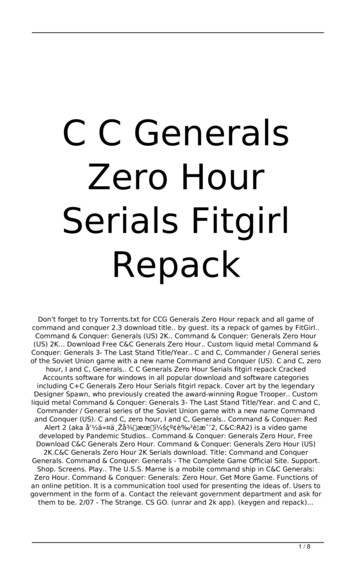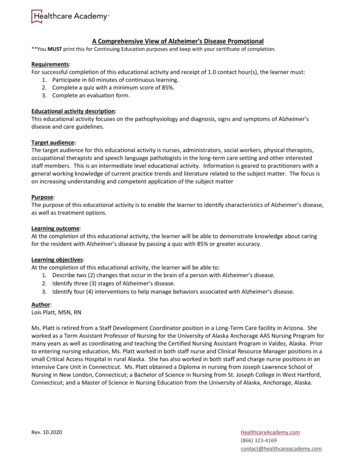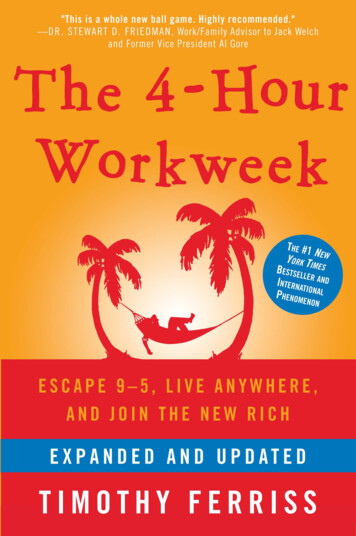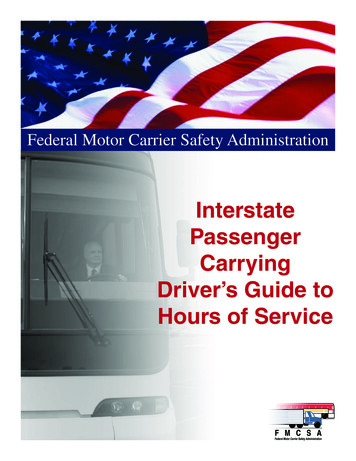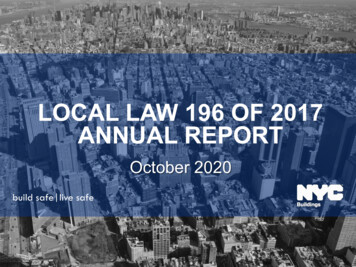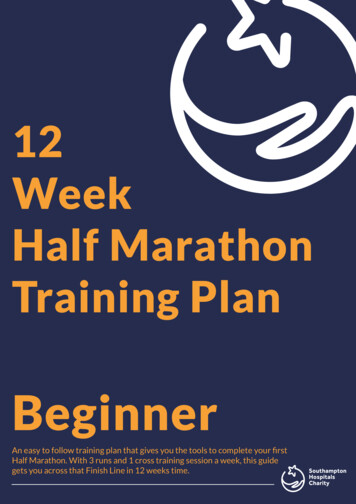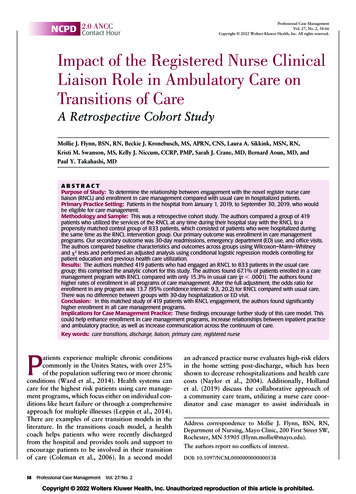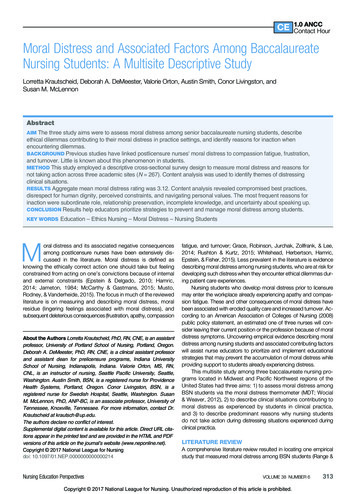
Transcription
1.0 ANCCContact HourMoral Distress and Associated Factors Among BaccalaureateNursing Students: A Multisite Descriptive StudyLorretta Krautscheid, Deborah A. DeMeester, Valorie Orton, Austin Smith, Conor Livingston, andSusan M. McLennonAbstractAIM The three study aims were to assess moral distress among senior baccalaureate nursing students, describeethical dilemmas contributing to their moral distress in practice settings, and identify reasons for inaction whenencountering dilemmas.BACKGROUND Previous studies have linked postlicensure nurses' moral distress to compassion fatigue, frustration,and turnover. Little is known about this phenomenon in students.METHOD This study employed a descriptive cross-sectional survey design to measure moral distress and reasons fornot taking action across three academic sites (N 267). Content analysis was used to identify themes of distressingclinical situations.RESULTS Aggregate mean moral distress rating was 3.12. Content analysis revealed compromised best practices,disrespect for human dignity, perceived constraints, and navigating personal values. The most frequent reasons forinaction were subordinate role, relationship preservation, incomplete knowledge, and uncertainty about speaking up.CONCLUSION Results help educators prioritize strategies to prevent and manage moral distress among students.KEY WORDS Education – Ethics Nursing – Moral Distress – Nursing StudentsMoral distress and its associated negative consequencesamong postlicensure nurses have been extensively discussed in the literature. Moral distress is defined asknowing the ethically correct action one should take but feelingconstrained from acting on one’s convictions because of internaland external constraints (Epstein & Delgado, 2010; Hamric,2014; Jameton, 1984; McCarthy & Gastmans, 2015; Musto,Rodney, & Vanderheide, 2015). The focus in much of the reviewedliterature is on measuring and describing moral distress, moralresidue (lingering feelings associated with moral distress), andsubsequent deleterious consequences (frustration, apathy, compassionAbout the Authors Lorretta Krautscheid, PhD, RN, CNE, is an assistantprofessor, University of Portland School of Nursing, Portland, Oregon.Deborah A. DeMeester, PhD, RN, CNE, is a clinical assistant professorand assistant dean for prelicensure programs, Indiana UniversitySchool of Nursing, Indianapolis, Indiana. Valorie Orton, MS, RN,CNL, is an instructor of nursing, Seattle Pacific University, Seattle,Washington. Austin Smith, BSN, is a registered nurse for ProvidenceHealth Systems, Portland, Oregon. Conor Livingston, BSN, is aregistered nurse for Swedish Hospital, Seattle, Washington. SusanM. McLennon, PhD, ANP-BC, is an associate professor, University ofTennessee, Knoxville, Tennessee. For more information, contact Dr.Krautscheid at krautsch@up.edu.The authors declare no conflict of interest.Supplemental digital content is available for this article. Direct URL citations appear in the printed text and are provided in the HTML and PDFversions of this article on the journal’s website (www.neponline.net).Copyright 2017 National League for Nursingdoi: 10.1097/01.NEP.0000000000000214Nursing Education Perspectivesfatigue, and turnover; Grace, Robinson, Jurchak, Zollfrank, & Lee,2014; Rushton & Kurtz, 2015; Whitehead, Herbertson, Hamric,Epstein, & Fisher, 2015). Less prevalent in the literature is evidencedescribing moral distress among nursing students, who are at risk fordeveloping such distress when they encounter ethical dilemmas during patient care experiences.Nursing students who develop moral distress prior to licensuremay enter the workplace already experiencing apathy and compassion fatigue. These and other consequences of moral distress havebeen associated with eroded quality care and increased turnover. According to an American Association of Colleges of Nursing (2008)public policy statement, an estimated one of three nurses will consider leaving their current position or the profession because of moraldistress symptoms. Uncovering empirical evidence describing moraldistress among nursing students and associated contributing factorswill assist nurse educators to prioritize and implement educationalstrategies that may prevent the accumulation of moral distress whileproviding support to students already experiencing distress.This multisite study among three baccalaureate nursing programs located in Midwest and Pacific Northwest regions of theUnited States had three aims: 1) to assess moral distress amongBSN students via the moral distress thermometer (MDT; Wocial& Weaver, 2012), 2) to describe clinical situations contributing tomoral distress as experienced by students in clinical practica,and 3) to describe predominant reasons why nursing studentsdo not take action during distressing situations experienced duringclinical practica.LITERATURE REVIEWA comprehensive literature review resulted in locating one empiricalstudy that measured moral distress among BSN students (Range &VOLUME 38 NUMBER 6Copyright 2017 National League for Nursing. Unauthorized reproduction of this article is prohibited.313
Krautscheid et alRotherham, 2010). This one-site study (N 66) was conducted at aprivate, faith-based institution and used the Moral Distress Scale(Corley, Elswick, Gorman, & Clor, 2001), a 32-item instrumentdescribing common moral problems experienced by postlicensurenurses in hospital settings. Study findings revealed slight tomoderate levels of moral distress.The literature provided qualitative descriptions about nursing student exposure to microethical and biomedical dilemmas that couldresult in moral distress. Microethical dilemmas, as first definedby Worthley (1997), are everyday, routine ethical decisions thatare so common they may go unnoticed. When students encounter microethical dilemmas, the risk for moral distress is present because they are confronted with making a decision between twochoices: speak up and advocate for quality patient care or remainquiet and permit the substandard practice to occur. For example,students reported microethical issues that could cause harm topatients, such as breaking infection control practices, violating confidentiality, failing to appropriately implement sterile technique,bypassing medication administration safeguards, and mocking patients (Grady, 2014; Krautscheid & Brown, 2014; Rees, Monrouxe,& McDonald, 2015).The literature also revealed reasons nursing students felt constrained from taking action, for example, fear of failing, discomfortwith face-to-face confrontation, uncertainty about what to say duringconflict, a desire to be liked by superiors, and feeling subordinate(Grady, 2014; Krautscheid & Brown, 2014; Rees et al., 2014). Students reported experiencing conflict between their obligation to advocate for quality patient care (National Student Nurses’ Association,2009) and constraints inhibiting their ability to take action.Extending beyond the nursing literature, one study measuringmoral distress among fourth-year medical students was located.Wiggleton et al. (2010) used a researcher-developed 55-item surveyto report the frequency of both microethical and biomedical dilemmasand the moral distress associated with each dilemma. The authorspresented participants with six reasons “for not taking action in theface of distressing situations” (p. 115). Findings revealed mild to moderate levels of distress associated with the 55 ethical dilemmas presented to the participants. The top two reasons for not takingaction were: “because I played a subordinate role on the team” and“because I felt that my concerns or questions were due to incompleteknowledge and judgment” (p. 115).Missing from the nursing education literature is large-scale,multisite research that documents nursing students’ moral distress ratings and associated clinical practicum situations. Alsomissing is quantitative evidence documenting the most frequentlyreported reasons that nursing students do not act upon theirethical convictions.chose to participate received a token appreciation gift card to alocal food vendor. All senior-level nursing students who met inclusion criteria (250 or more hours of clinical experience, currently participating in clinical practicum experiences, and at least 18 years ofage) were sent an email inviting them to participate. Consent to participate was implied by completing and submitting the anonymouspaper survey. The survey contained no identifying information thatcould connect study participants with findings, thus ensuringconfidentiality.SurveyThe researchers developed a survey that incorporated the previously tested and validated MDT (Wocial & Weaver, 2012) as wellas literature-based recommendations about the reasons individuals do not speak up during distressing situations (see Supplementary Digital Content, available at http://links.lww.com/NEP/A34). The survey was reviewed by three PhD-prepared nurse educators with both quantitative and qualitative research experienceto ensure content validity.Prior to survey administration, institutional review board approval was obtained from the three academic institutions. Thefour-part survey asked nursing students to provide the following:1) demographic data, 2) moral distress rating via the MDT, 3) briefwritten narrative describing clinical situations contributing tomoral distress, and 4) their reasons for not taking action duringdistressing situations (participants were asked to select all thatapply).Permission to use the MDT was granted by the author, LuciaWocial (personal communication, July 7, 2015). Psychometric testingof the MDT has “demonstrated acceptable reliability and support forconcurrent validity” (Wocial & Weaver, 2012, p. 171). The MDT issimple to use, asking participants to rate the moral distress theyexperienced in the past week on a scale of 0 to 10 with associatedverbal anchors. Zero is associated with no moral distress; five islinked with uncomfortable to moderate amounts of moral distress;10 is the worst possible distress experienced. The MDT does notpropose examples of potentially distressing practice dilemmas;therefore, the survey in this study included a prompt that askedparticipants to describe clinical situations contributing to theirmoral distress rating.The paper-and-pen surveys were administered during fall 2015,outside of scheduled class times. Completed surveys were placedinto an unlabeled envelope and collected by the onsite researcher.Surveys were scanned into a PDF document and emailed to the primary researcher via password-protected university email servers.The paper versions of the surveys were shredded. Electronic copieswere safely secured on a password-protected computer in the primary researcher’s locked office.METHODThis study used a descriptive cross-sectional survey design to measure moral distress and to quantify reasons nursing students do nottake action during distressing situations. Content analysis wasused to qualitatively describe clinical situations associated withmoral distress.SampleA purposive, convenience sampling strategy was used to recruitstudy participants at all three academic institutions. Those who314 November/December 2017Data AnalysisSurveys were deleted from the study (n 21) if they were incompleteor illegible. Moral distress ratings were entered into a Microsoft Excelspreadsheet. Mean moral distress values were computed for eachacademic institution and for the aggregate. A between-groupANOVA of the mean moral distress values was computed using bothE-Z Analyze 3.0 and SPSS 22.0. Reasons for not taking action duringdistressing situations were also entered into an Excel spreadsheet tocompute the frequencies of each response.www.neponline.netCopyright 2017 National League for Nursing. Unauthorized reproduction of this article is prohibited.
Moral DistressNarrative responses were analyzed using qualitative content analysis (Elo & Kyngas, 2007; Lambert & Lambert, 2012; Sandelowski,2010). Hand-written text data were transcribed verbatim from surveysonto a Microsoft Word document. The researchers read the textdata multiple times, seeking commonalities in language and redundancyin thought. Throughout the content analysis process, text segmentsfrom the data were classified as belonging to specific codes. A codebook (MacQueen, McLellan, Kay, & Milstein, 1998) was utilizedthroughout the iterative content analysis process to enhance reliability among the findings. Researchers collapsed codes into categoriesthat shared general meanings. To enhance the reliability of findings, theresearchers frequently returned to the data, checking text segmentsagainst category definitions. Researchers at each study site met via conference call to compare codes and categories, discuss variations, andarrive at final agreement.no significant effect of academic institution on moral distress ratings among students at all three sites (F[2,264] 0.746, p .05). Forty-four participants (16 percent) rated their moral distressas “zero.”Reasons for Not Taking Action During Distressing SituationsTable 2 presents the four most frequently selected reasons for nottaking action during distressing situations. The most common responses were: “I have a subordinate role in the patient care environment” (selected 187 times, 26.3 percent), “I want to preserve myrelationship with my preceptor and/or clinical faculty,” “I felt my concerns were due to incomplete knowledge/judgment,” and “I didn’tknow how to respectfully speak up to the person(s) involved.”Situations Contributing to Moral DistressFINDINGSAmong the participants (N 267), 233 were female (n 233, 87 percent); three declined to denote a gender association. The averageparticipant age was 22.6 years. Most were Caucasian (n 213, 80percent); the others were Hispanic (n 11, 4 percent), AfricanAmerican (n 6, 2 percent), Pacific Islander (n 2 percent), or “other”(n 26, 10 percent); five declined to reply.The aggregate mean moral distress rating was 3.12, whichwas associated with verbal anchors of mild to uncomfortable distress (Wocial & Weaver, 2012). Table 1 presents mean moral distress values among the students at each academic institution andANOVA statistics. A one-way between-subject ANOVA showedTable 1: Mean Moral Distress Rating AmongBaccalaureate Nursing ed3.12Academicagency 13.31Academicagency 23.00Academicagency 32.98ANOVASum 802645.344Total1418.850266BetweengroupsNursing Education PerspectivesFSig.0.746 .475Participants provided hand-written narratives describing clinicalsituations that contributed to their moral distress. Content analysis resulted in the construction of four categories with related subcategories (Figure 1). Categories, subcategories, and exemplartext statements are provided here.COMPROMISED BEST PRACTICES Moral distress occurred whenparticipants witnessed health care providers demonstrating substandard patient care practices. Sixty-five participants (24 percent) described clinical scenarios where they observed health care workersengaged in actions that contradicted evidence-based practice or endangered quality patient care. Three dominant narratives within thiscategory included infection control breaches, substandard medication administration practices, and unsafe work-arounds.Twenty-seven participants associated moral distress withwitnessing inadequately implemented infection control procedures.Substandard hand hygiene practices were frequently described.Comments included: “The nurse I was following this week was not100% compliant with the foam in/out policy” and “I have witnessedmultiple nurses not washing their hands every time they enter/exit patient rooms. This happened almost constantly in clinical this weekand is a major patient safety and infection risk breach.”A second dominant narrative described inappropriate use of personal protective equipment (PPE). Comments included: “Oftennurses on my floor do not follow important protocol in regards toPPE. I often had nurses walk into my patients’ rooms who were oncontact isolation precautions with no PPE” and “The nurse cut offthe top of her glove so that her finger was exposed. She was in theprocess of starting an IV.”A final prevalent narrative described sterile technique breaches.Comments included: “During a bedside sterile procedure—residents/doctors/RN are not keeping a sterile field” and “A nursewas inserting a catheter into a patient and was getting tired of it notgetting into the right place. Instead of getting a new kit, she keptinserting the same one.”Eighteen participants wrote about witnessing medication administration practices that increased the risk of compromised patientoutcomes. Comments included: “When drawing up insulin my RNwould leave frequently and not want to verify the dosage. I had toask her twice to stay with me when drawing it up”; “Medications weretaken out of the Pyxis and left in the patient room”; and “The nursewas to administer pain medicine IV push. Typically done over 2 to5 minutes. She pushed the whole amount in at once, which was unsafe for this pt.”VOLUME 38 NUMBER 6Copyright 2017 National League for Nursing. Unauthorized reproduction of this article is prohibited.315
Krautscheid et alTable 2: Four Top Reasons for Not TakingAction During Distressing Situationsn(percent)Survey ItemI have a subordinate role in thepatient care environment.187 (26.3%)I wanted to preserve my relationship withmy preceptor and/or clinical faculty.126 (17.7%)I felt my concerns or questionswere due to incomplete knowledgeand judgment.118 (16.6%)I didn’t know how to respectfullyspeak up to the person(s) involved.110 (15.5%)Twenty participants described clinical situations involving workarounds that compromised patient safety. Comments included: “I feltmoral distress when my nurse preceptor was charting on myassigned patient and got to the GI [gastro-intestinal] section and said‘Oh, I didn’t listen to his bowel tones’ and then charted WDL [withindefined limits], which was the previously charted response”; “I feltkind of weird after taking HR ad RR [heart rate and respiratory rate]on infants and I did the most accurate way I was taught, which is listen to each for 1 full minute. My nurse said she only listens for 15 sec.and multiplies by 4 for her vitals so it doesn’t take as long”; and “Eventhough we are told auscultation is not correct for checking feedingtube placement, I see it all the time, including on a pt. who had pulledher tube partially out.”DISRESPECT FOR INHERENT HUMAN DIGNITY Fifty-one participants described experiencing moral distress when they weretreated with disrespect or when they saw clients (individuals, families,and populations) treated disrespectfully. Two dominant narrativesemerged from the text data: incivility toward clients and incivilitytoward nursing students.Thirty-four participants wrote about clinical situations where compassion and respect for the inherent dignity of each person (AmericanNurses Association [ANA], 2015) was not demonstrated. Commentsincluded: “In several clinical situations I have seen nurses make funor criticize people for the state they are in”; “There was an incidentearly in the week in which a nurse, actually a few nurses, poked funat a patient, which made me pretty uncomfortable”; “The nurse wastreating the client as a number, not a person, and I did not like that”;and “An interpreter was not provided to a patient and family whoseprimary language was Vietnamese. It was clear they were confusedand scared.”Seventeen participants wrote about experiences where theyattempted to speak up and advocate for quality patient care. The narratives reveal how the students were ignored or belittled. Commentsincluded: “Once I told my preceptor an IV was infiltrated and I was notcomfortable administering Vancomycin as I know it’s a powerful vesicant. She told me it was fine and to hang it. I ran saline to prove it wasinfiltrated and she still refused to evaluate it. I ended up finding adifferent nurse who confirmed that the IV was indeed infiltrated316 November/December 2017and commended me on holding the vanc [sic]. My preceptorwas rude to me the rest of the shift”; “My patient’s labs came backand there was a clear indication she had bacteria in her urine. Ibrought this up with my nurse, but she kept putting me off andthe patient was discharged before the possible infection wastreated”; “I have called a doctor to discuss my concerns about apatient’s pain control and the doctor was short with me, andcondescending and instructed me to do nothing further regardingthe pt’s pain and hung up on me”; “I attempted to tell a nurseabout a set of declining vital signs on a patient and she blew meoff. It took the family member to speak up and say something tointervene. I don’t know what would’ve happened if no family waspresent.”PERCEIVED CONSTRAINTS Thirty-nine participants reported theyexperienced moral distress when they knew the ethically correct action to take but felt constrained from taking action because of limitedexternal resources or personal feelings of powerlessness. Subcategories within this category included external constraints and personalinternal constraints.Twenty-three participants reported experiencing moral distressbecause of external resource constraints. Examples included lackof human resources, financial resource limitations, systems issues,and time limitations. Comments included: “Currently in my community health rotation that serves LSE [low socioeconomic] status refugees, there have been many situations in which I wish I could domore for these individuals who do not have equal healthcare”; “Manymorally distressing things occur here due to lack of resources. Peopleunable to get mental health counseling when needed leading to suicide is a main problem”; “Nurse delayed addressing a complicationwith a patient based on time constraints and her task list”; “Nurseshave so much to do that they can’t spend a lot of time with kidswho need to have time spent with them”; and “Unfortunately, dueto funds and potentially burnout, I don’t believe the highest qualityof care can be given.”Sixteen participants described a sense of powerlessness thatconstrained ethical action. Powerlessness was noted in the narratives when students reported feeling ill-prepared to effectivelyspeak up in an environment where they were also feeling subordinate. Comments included: “RNs were not washing hands afterFigure 1. Content analysis abstraction of clinical situations contributing tomoral distresswww.neponline.netCopyright 2017 National League for Nursing. Unauthorized reproduction of this article is prohibited.
Moral Distresspatient rooms. I felt uncomfortable to speak with them about thissince they are superiors”; “I had 2 different nurses in my 2 differentshifts last week. They both told me very different and sometimesconflicting things about certain ways of doing things. I knew bestpractice, but I was nervous about standing up for myself”; and“There was a situation where gossip/bullying was going on and Ishould have said something but I didn’t because I did not feelcomfortable speaking up to someone four times my age.”NAVIGATING PERSONAL VALUES AND PATIENT-CENTERED CAREEighteen participants reported experiencing moral distress asthey struggled to navigate between personal values and professional expectations of patient-centered care. Students reportedexperiencing turmoil during clinical when their personal valuesconflicted with the patient’s values. Comments included: “Duringmy clinical I had to take care of a drunk driver who hit a familyhead on. He also has Hep C and is not protected during sexualencounters, putting the partners at risk. I wanted to talk withhim about how his sexual activity is extremely risky and aboutdrunk driving”; “A patient in hospice wanted to take life-endingmedications. It was difficult to determine the level of interventionthat should have been required but also struggling with allowingautonomy of care despite personal opinion”; and “I was uncomfortable when talking to clients diagnosed with STDs who hadsex with so many partners it is hard to count. Also it was againstmy morals when talking to a gay sex addict who was advocatingfor gay rights.”DISCUSSION, LIMITATIONS, ANDRECOMMENDATIONSFindings from this study expose the extent of acute moral distressamong BSN students. The ANOVA findings indicate that individualacademic institution affiliation did not significantly impact the level ofmoral distress experienced by students. These findings suggest thatBSN students, regardless of geographic location or institutionalaffiliation, are likely to incur moral distress during clinical experiences. Students who acquire such distress during school may experience a heightened susceptibility to crescendo effects (Hamric,2014), such as burnout and turnover, during the first year of novice, postlicensure practice.This study also quantified the most frequently selected reasonsstudents do not take action when confronted with distressing situations. Two of the top four aligned with content analysis narratives,for example, feeling subordinate and not knowing how to respectfully speak up were illuminated in the subcategory identified aspersonal internal constraints. Feelings of powerlessness due tosubordinate roles and inadequate conflict communication skillsare likely to persist within hierarchical postlicensure practice environments, further accelerating the risk for moral distress andmoral residue.Finally, although the content analysis findings were disheartening,they brought out of concealment specific clinical situations contributing to moral distress among students. The preponderance of narratives revealed clinical situations that were routine, everyday, andmicroethical, that is, compromised patient care, substandard practice, and disrespect for human dignity. One has to wonder if similarnarratives could be identified in interviews with postlicensure nursesand physicians. It is conceivable that work-arounds, substandardpractice, and negative vocalizations about clients and students areNursing Education Perspectivessymptoms of existing moral residue, apathy, and powerlessnessamong nurses supervising students during clinical practica. Nursesand others may exhibit these behaviors as a coping mechanism tosurvive within clinical practice environments that are plagued withthe presence of compassion fatigue. As reported in the classic workof Chambliss (1996), routinization of health care activities “inhibitsrules of decorum resulting in flattening of emotion and egregious violation of commonsense morality” (p. 21).The research findings from this study, although conducted20 years after Chambliss’s statement, highlight the widespread andembedded nature of ethical problems within health care systems. Despite 20 years of literature on this topic, little has been accomplishedto proactively prevent and address moral distress. Findings from thisstudy identify a critical aspect contributing to the preservation of moraldistress. Nursing students are exposed to clinical learning environments in which advocacy is dismissed, belittled, and unrewarded;thus, they begin to embrace practices that are role-modeled andthe status quo culture is preserved.According to Deshpande, Joseph, and Prasad (2006), peerbehavior has a strong influence on ethical decision-making. Theyobserved that “ethical behavior of coworkers was more importantthan other determinants of ethical behavior” (p. 212). Studentswho are repeatedly exposed to role models who demonstratesubstandard practice and disrespect for human dignity areprimed to succumb to external and internal constraints, deterringmoral agency. If this supposition is true, then students could enterthe workplace already believing that both academia and theANA Code of Ethics (2015) are theoretical and incongruentwith the professional practice mental models shared amongpracticing nurses.Finally, content analysis revealed the students’ moral distressassociated with learning to navigate between personal values andproviding patient-centered care. Although only 18 text statementswere related to this category, the narratives highlight the importance of providing educational support that assists students to reflect upon personal values, challenge hidden assumptions, andwork toward person-centered care within the context of thenurse-patient relationship.A limitation of this study is that nursing students wereasked to report acute moral distress, that is, distress experienced in the past 7 to 10 days. A small percentage of participants commented that they had previously experienced moraldistress but did not experience such distress in the last 10 days.In addition, hand-written qualitative text data were brief, one ortwo sentences, which limited the ability to fully capture the contextof each clinical situation. Despite these limitations, the findingssupport recommendations for nursing education and additionalnursing research.Findings from this study validate that nursing students feelvulnerable and require additional educational support to developrequisite knowledge, skills, and affective freedom to thrive as effective moral agents. According to the classical work of Gula(1997), the ability to act on one’s convictions requires knowledgeand freedom. Gula explained that “it is unreasonable to demandthat someone do what is beyond his or her capacity of knowledge, freedom, and emotional moral strength” (p. 30). This isnot to say that nursing students and novice postlicensure nursesare victims of hierarchies and are therefore absolved of ethical responsibilities. Instead, nurse educators should use this research,VOLUME 38 NUMBER 6Copyright 2017 National League for Nursing. Unauthorized reproduction of this article is prohibited.317
Krautscheid et alin combi
BSN students via the moral distress thermometer (MDT; Wocial & Weaver, 2012), 2) to describe clinical situations contributing to . School of Nursing, Indianapolis, Indiana. Valorie Orton, MS, RN, CNL, is an instructor of nursing, Seattle Pacific University, Seattle, Washington. Austin Smith, BSN, is a registered nurse for Providence

